In the first part, the Cosmic Diagram was discussed that appeared in the 1926 Lost Continent of Mu Motherland of Men and the 1931 Lost Continent of Mu. This posting covers the 1933 Sacred Symbols of Mu.
And the accompanying description in the text:
MU’S COSMOGONIC DIAGRAM.–The Cosmogonic Diagram of Mu was the mother of all the various cosmogonic diagrams found throughout the world. All subsequent diagrams were based on that of the Motherland.
Inventions, alterations, additions in lines to adapt them to new meanings, made nightmares of them all.
One of the most prominent additions in the Hindu, Babylonian, Assyrian, Chaldean and Egyptian was the addition of a hell. This hell is shown in various diagrams as a small circle below the main figure, the outside of the circle symbolizing the Universe, which was putting it far away from the earth. As the devil was unknown in Mu, no hell appears in her cosmogonic diagram.
DECIPHERING MU’S DIAGRAM.–In Mu the novice was taught to learn the diagram thoroughly and repeat what was written upon it as his spiritual convictions. just as children are taught the Bible today, the children of lost Mu were instructed in this diagram.
THE CONSTRUCTION OF THE DIAGRAM.–In the center is a circle within two crossed and interwoven triangles. Being interwoven or interlaced, these triangles form but one figure.
These two triangles are enclosed within a second circle, thus leaving twelve divisions.
Beyond this circle is a third, leaving a space between the two.
On the outside of this third circle are 12 scallops. Falling from the outside of the scallops is a ribbon which has 8 divisions.
THE MEANINGS OF THESE FIGURES.–The central circle is a picture of the Sun and the symbol of the Deity whose abode is Heaven.
The twelve divisions, formed by the crossing of the two triangles, are the gates to Heaven where dwells the Heavenly Father. These gates symbolize virtues, the twelve great earthly virtues, which man must possess before he can enter the gates, among them being Love, Hope, Charity, Chastity, Faith, et cetera. Love stands at the head of the list.The space between the second and third circles is the world beyond, which the soul must pass through to reach the gates of Heaven.
The twelve scallops on the outside of the outer circle are the gates to the world beyond and symbolize the twelve great earthly temptations which must be overcome by the material body, before the soul can pass through these gates to the world beyond.
The ribbon with the eight divisions symbolizes the eight roads to Heaven and tells what man’s actions and thoughts must be to ascend to the gates of the world beyond. Put into present language the foregoing would read:
THE BELIEF.–I believe there are eight roads to travel to reach Heaven (mentioning them). My soul will first arrive after travelling these roads at the gates to the world beyond. To enter these my soul must show that my earthly body overcame the twelve great earthly temptations (mentioning them). Having shown that it had done so, my soul will be allowed to Pass into the world beyond. This I must traverse until I reach the gates of Heaven. Here my soul must prove that my earthly body possessed the twelve great virtues (mentioning them). Having shown that it did, my soul will then be passed through the gates into Heaven to the Throne of Glory, where sits the Heavenly Father waiting to receive it.
Have we anything today in any of our religions and religious sects that will compare with this beautiful conception so simply worded?
This was the Religion of Mu, the Motherland, and the First Religion of Man.
Comparing the differences between the versions:
| Lost Continent of Mu (1926 & 1931) | Sacred Symbols of Mu |
| I believe there are eight roads which I must travel in order to reach Heaven. | I believe there are eight roads to travel to reach Heaven (mentioning them). |
| After having traveled the eight roads (mentioning them), I arrive at the twelve gates leading to the world beyond. | My soul will first arrive after travelling these roads at the gates to the world beyond. |
| Here I must prove that I have overcome the twelve earthly temptations (mentioning them) | To enter these my soul must show that my earthly body overcame the twelve great earthly temptations (mentioning them). |
| I shall then pass through into the world beyond and reach the gates of Heaven. | Having shown that it had done so, my soul will be allowed to Pass into the world beyond. This I must traverse until I reach the gates of Heaven |
| There I must show that I learned and practised the twelve virtues on earth (mentioning them). | Here my soul must prove that my earthly body possessed the twelve great virtues (mentioning them). |
| Then I am taken through the gates of Heaven to the throne of glory, where sits the Heavenly King. | Having shown that it did, my soul will then be passed through the gates into Heaven to the Throne of Glory, where sits the Heavenly Father waiting to receive it. |
In part 1, both versions (1926 Lost Continent of Mu Motherland of Men and the 1931 Lost Continent of Mu) supplied the following:
What the twelve temptations and the twelve virtues were I was never able to discover collectively.
However, in the 1933 Sacred Symbol of Mu it appears that he was able to discover some of the virtues:
the twelve great earthly virtues, which man must possess before he can enter the gates, among them being Love, Hope, Charity, Chastity, Faith, et cetera. Love stands at the head of the list.
James also includes other Cosmogonic Diagrams in the Sacred Symbols of Mu, as shown below:
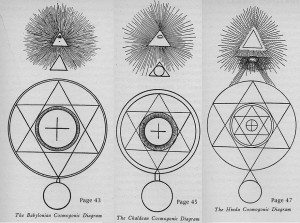
In the next installment, some possible sources for the Cosmogonic/Cosmic Diagrams will be examined.

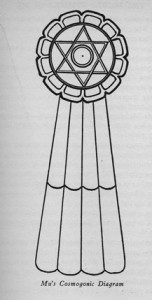

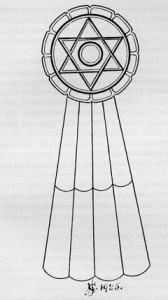

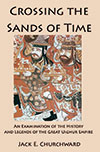
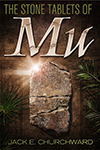
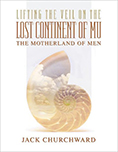



 RSS - Posts
RSS - Posts